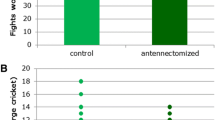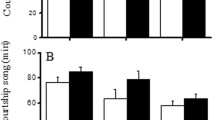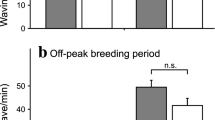Abstract
Agonistic encounters of juvenile male crickets were analyzed behaviourally. In a pairing between adult and juvenile male crickets, the juvenile crickets were usually beaten by the adult males of over 3 days after their final moult. Juveniles, by contrast, won significantly more bouts against young adult males 2 days after their final moult. These findings are good indicators to predict which cricket will defeat which opponent. To examine the effect of previous social experience, two juvenile animals were paired first and then juveniles that became subordinate were paired with day 2 adults, while juveniles that became dominant were paired with day 3 adults 5 min after first pairing. Subordinate juveniles were beaten by day 2 adults, while dominant juveniles tended to win against day 3 adults. This is the first time that winner and loser effects have been demonstrated in juvenile crickets. Similar pairings with day 2 or day 3 adult males were performed 2 h after first pairings. Subordinate juveniles were still beaten by day 2 adults, while the winning rate of dominant juveniles against day 3 adults was decreased significantly. These results suggest that the retention time of loser effect lasted more than 2 h while that of the winner effect disappeared within a shorter period.




Similar content being viewed by others
References
Abbott JC, Dunbrack RL, Orr CD (1985) The interaction of size and experience in dominance relationships of juvenile steelhead trout (Salmo gairdneri). Behaviour 92:241–253
Abe T, Fujiyama N, Tomimatsu H, Nagayama T (2018) Age-dependent and social status-dependent behavioural plasticity of the cricket Gryllus bimaculatus. Anim Behav 14:1–7
Adamo SA, Hoy RR (1995) Agonistic behaviour in male and female field crickets, Gryllus bimacufatus, and how behavioural context influences its expression. Anim Behav 49:1491–1501
Adamo SA, Linn CE, Hoy RR (1995) The role of neurohormonal octopamine during 'fight or flight' behaviour in the field cricket Gryllus bimaculatus. J Exp Biol 198:1691–1700
Alexander RD (1961) Aggressiveness, territoriality, and sexual behavior in field crickets (Orthoptera: Gryllidae). Behaviour 17:130–223
Anand AN, Lorenz MW (2008) Age-dependent changes of fat body stores and the regulation of fat body lipid synthesis and mobilisation by adipokinetic hormone in the last larval instar of the cricket, Gryllus bimaculatus. J Insect Physiol 54:1404–1412
Bakker ThCM, Bruijn E, Sevenster P (1989) Asymmetrical effects of prior winning and losing on dominance in sticklebacks (Gasterosteus aculeatus). Ethology 82:224–229
Balsam JS, Stevenson PA (2020) Pre-adult aggression and its long-term behavioural consequences in crickets. PLoS ONE 15:e0230743
Beacham JL, Newman JA (1987) Social experience and the formation of dominance relationships in the Pumpkinseed sunfish, Lepomis gibbosus. Anim Behav 35:1560–1563
Bergman DA, Kozlowski CP, Meintyre JC, Huber R, Daws A, Moore PA (2003) Temporal dynamics and communication of winner-effects in the crayfish, Orconectes restucus. Behaviour 140:805–825
Briffa M, Elwood RW (2004) Use of energy reserves in fighting hermit crabs. Proc R Soc Lond B Biol Sci 271:373–379
Bovbjerg RV (1953) Dominance order in the crayfish, Orconectes virilis (Hagan). Physiol Zool 26:173–178
Chase ID, Bartolomeo C, Dugatkin LA (1994) Aggressive interactions and inter-contest interval: how long do winners keep winning? Anim Behav 48:394–400
Clutton-Brock TH, Albon SD, Gibson RM, Guinness FE (1979) The logical stag: adaptive aspects of fighting in red deer (Cervus elaphus L.). Anim Behav 27:211–225
Dixon KA, Cade WH (1986) Some factors influencing male-male aggression in the field cricket Gryllus integer (time of day, age, weight and sexual maturity). Anim Behav 34:340–346
Francis RC (1983) Experiential effects on agonistic behavior in the paradise fish, Macropodus opercularis. Behaviour 85:292–313
Frankel DG, Arbel T (1980) Group formation by two-year olds. Int J Behav Dev 3:287–298
Fuxjager MJ, Forbes-Lorman RM, Coss DJ, Auger CJ, Auger AP, Marler CA (2010) Winning territorial disputes selectively enhances androgen sensitivity in neural pathways related to motivation and social aggression. Proc Natl Acad Sci USA 107:12393–12398
Goldman L, Swanson H (1975) Population control in confined colonies of golden hamsters (Mesocricetus auratus Waterhouse). Z Tierpsychol 37:225–236
Goubault M, Decuigniere M (2012) Previous experience and contest outcome: winner effects persist in absence of evident loser effects in a parasitoid wasp. Am Nat 180:364–371
Hack MA (1997) Assessment strategies in the contests of male crickets, Acheta domesticus (L.). Anim Behav 53:733–747
Herberholz J, McCurdy C, Edwards DH (2007) Direct benefits of social dominance in juvenile crayfish. Biol Bull 213:21–27
Hofmann HA, Stevenson PA (2000) Flight restores fight in crickets. Nature 403:613
Hsu Y, Wolf LL (1999) The winner and loser effect: integrating multiple experiences. Anim Behav 57:903–910
Hsu Y, Earley RL, Wolf LL (2006) Modulation of aggressive behaviour by fighting experience: mechanisms and contest outcomes. Biol Rev 81:33–74
Iwasaki M, Delago A, Nishino H, Aonuma H (2006) Effects of previous experience on the agonistic behaviour of male crickets, Gryllus bimaculatus. Zool Sci 23:863–872
Kaczer L, Pedetta S, Maldonado H (2007) Aggressiveness and memory: Subordinate crabs present higher memory ability than dominants after an agonistic experience. Neurobiol Learn Mem 87:140–148
Kasumovic MM, Elias DO, Sivalinghem S, Mason AC, Andrade MCB (2010) Examination of prior contest experience and the retention of winner and loser effects. Behav Ecol 21:404–409
Khazraie K, Campan M (1999) The role of prior agonistic experience in dominance relationships in male crickets Gryllus bimaculatus (Orthoptera: Gryllidae). Behav Process 44:341–348
Lan YT, Hsu Y (2011) Prior contest experience exerts a long-term influence on subsequent winner and loser effects. Front Zool 8:28–10
Mathis A, Britzke E (1999) The roles of body size and experience in agonistic displays of the Ozark zigzag salamander, Plethodon angusticlavius. Herpetologica 55:344–352
Matsumoto Y, Hatano A, Unoki S, Mizunami M (2009) Stimulation of the cAMP system by the nitric oxide-cGMP system underlying the formation of long-term memory in an insect. Neurosci Lett 467:81–85
McDonald P, Topoff H (1986) The development of defensive behavior against predation by army ants. Dev Psychobiol 19:351–367
Mita A, Yoshida M, Nagayama T (2014) Nitric oxide modulates a swimmeret beating rhythm in the crayfish. J Exp Biol 217:4423–4431
Momohara Y, Kanai A, Nagayama T (2013) Aminergic control of social status in crayfish agonistic encounters. PLoS ONE 8:e74489
Momohara Y, Yoshida M, Nagayama T (2015) Serotonergic modulation of social status-dependent behavioural plasticity of the crayfish avoidance reaction. J Comp Physiol A 201:1063–1074
Momohara Y, Minami H, Kanai A, Nagayama T (2016) Role of cAMP signalling in winner and loser effects in crayfish agonistic encounters. Eur J Neurosci 44:1886–1895
Momohara Y, Aonuma H, Nagayama T (2018) Tyraminergic modulation of agonistic outcomes in crayfish. J Comp Physiol A 204:465–473
Moore AJ, Clccone WJ, Breed MD (1988) The influence of social experience on the behavior of male cockroaches, Nauphoeta cinerea. J Insect Behav 1:157–168
Otronen M (1990) The effect of prior experience on the outcome of fights in the burying beetle, Nicrophorus humatio. Anim Behav 40:980–1004
Rillich J, Stevenson PA (2014) A fighter's comeback: dopamine is necessary for recovery of aggression after social defeat in crickets. Horm Behav 66:696–704
Rillich J, Stevenson PA (2017) Losing without fighting—simple aversive stimulation induces submissiveness typical for social defeat via the action of nitric oxide, but only when preceded by an aggression priming stimulus. Front Behav Neurosci 11:1–15
Rillich J, Stevenson PA (2018) Serotonin mediates depression of aggression after acute and chronic social defeat stress in a model insect. Front Behav Neurosci 12:233
Rose J, Rillich J, Stevenson PA (2017) Chronic social defeat induces long-term behavioral depression of aggressive motivation in an invertebrate model system. PLoS ONE 12:e0184121
Röseler P-F, Röseler I, Strambi A, Augier R (1984) Influence of insect hormones on the establishment of dominance hierarcxhies among foundresses of the paper wasp, Polistes gallicus. Behav Ecol Sociobiol 15:133–142
Röseler P-F, Röseler I, Strambi A (1985) Role of ovaries and ecdysteroids in dominance hierarchy establishment among foundresses of the primitively social wasp, Polistes gallicus. Behav Ecol Sociobiol 18:9–13
Rutte C, Taborsky M, Brinkhof MWG (2006) What sets the odds of winning and losing? Trends Ecol 21:16–21
Sato D, Nagayama T (2012) Development of agonistic encounters in dominance hierarchy formation in juvenile crayfish. J Exp Biol 215:1210–1217
Schuett GW (1997) Body size and agonistic experience affect dominance and mating success in male copperheads. Anim Behav 54:213–224
Shiratori C, Suzuki N, Momohara Y, Shiraishi K, Aonuma H, Nagayama T (2017) Cyclic AMP-regulated opposing and parallel effects of serotonin and dopamine on phototaxis in the Marmorkrebs (marbled crayfish). Eur J Neurosci 46:1863–1874
Sneddon LU, Huntingford FA, Taylor AC, Orr JF (2000) Weapon strength and competitive success in the fights of shore crabs (Carcinus maenas). J Zool 250:397–403
Stevenson PA, Hofmann HA, Schoch K, Schildberger K (2000) The fight and flight responses of crickets depleted of biogenic amines. J Neurobiol 43:107–120
Stevenson PA, Dyakonova V, Rillich J, Schildberger K (2005) Octopamine and experience-dependent modulation of aggression in crickets. J Neurosci 25:1431–1441
Tokarz RR (1985) Body size as a factor determining dominance in staged agonistic encounters between male brown anoles (Anolis sagrei). Anim Behav 33:746–753
Ueno R, Nagayama T (2012) Interlocking of chelae is a key factor for dominance hierarchy formation in crayfish. J Exp Biol 215:2841–2848
Whitehouse MA (1997) Experience influences male-male contests in the spider Argyrodes antipodiana (Theridiidae: Araneae). Anim Behav 53:913–923
Wilson EO (1975) Sociobiology. Harvard University Press, New York
Acknowledgements
We are grateful to Prof. PL Newland for his critical reading of the manuscript. This work was supported by Grants- in-Aid from the Ministry of Education, Science, Sport, and Culture to TN (16K07432). All experiments were carried out in accordance with the Guide for the Care and Use of Laboratory Animals of Yamagata University (Japan).
Author information
Authors and Affiliations
Corresponding author
Additional information
Publisher's Note
Springer Nature remains neutral with regard to jurisdictional claims in published maps and institutional affiliations.
About this article
Cite this article
Abe, T., Tada, C. & Nagayama, T. Winner and loser effects of juvenile cricket Gryllus bimaculatus. J Ethol 39, 47–54 (2021). https://doi.org/10.1007/s10164-020-00671-1
Received:
Accepted:
Published:
Issue Date:
DOI: https://doi.org/10.1007/s10164-020-00671-1




